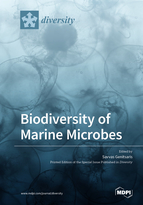Biodiversity of Marine Microbes
A special issue of Diversity (ISSN 1424-2818). This special issue belongs to the section "Marine Diversity".
Deadline for manuscript submissions: closed (30 April 2020) | Viewed by 22091
Special Issue Editor
Interests: microbial ecology; molecular diversity of microbes; metagenomics; bioinformatics
Special Issues, Collections and Topics in MDPI journals
Special Issue Information
Dear Colleagues,
Marine microbial life is comprised of a variety of different evolutionary groups from all three domains of life, Eukaryotes, Bacteria, and Archaea. It is responsible for about half of the primary production on earth, plays irreplaceable roles in biogeochemical cycles and ecosystem functioning, and actively participates in complex processes and interactions. Marine microbes are the basis of marine trophic webs (autotrophs), and also an important link between different trophic levels (decomposers, parasites, and endosymbionts). They are used as biological indicators of water quality, eutrophication, and degraded marine environments, and are targeted in conservation and restoration plans. Our understanding of their responses to climate change is considered a key research field to comprehend the complex ongoing processes that will shape the planet’s future. They consist of a vast diversity of organisms, with diverse morphological features, sizes, physiology, functions, trophic characteristics, distribution, ecology, evolutionary traits, genetic content, and responses to abiotic variability. Even though we understand their significance in numerous aspects that affect all life on earth, we still have a long way to go in order to answer fundamental questions driving recent research: How many marine microbes are there? Where can we find them? What do they do? What is their role and responses in the light of climate change? What are their phylogenetic relationships? How do they respond to environmental pressures? And many more. Recent advances in high-throughput sequencing accompanied with the technological innovations of classical tools, such as microscopy, have given researchers the equipment and the incentive to attempt to tackle the above questions and shed light on the complex and diverse life of marine microbes. This Special Issue provides a platform to highlight new research and significant advances related to the biodiversity of marine microbes.
Dr. Savvas Genitsaris
Guest Editor
Manuscript Submission Information
Manuscripts should be submitted online at www.mdpi.com by registering and logging in to this website. Once you are registered, click here to go to the submission form. Manuscripts can be submitted until the deadline. All submissions that pass pre-check are peer-reviewed. Accepted papers will be published continuously in the journal (as soon as accepted) and will be listed together on the special issue website. Research articles, review articles as well as short communications are invited. For planned papers, a title and short abstract (about 100 words) can be sent to the Editorial Office for announcement on this website.
Submitted manuscripts should not have been published previously, nor be under consideration for publication elsewhere (except conference proceedings papers). All manuscripts are thoroughly refereed through a single-blind peer-review process. A guide for authors and other relevant information for submission of manuscripts is available on the Instructions for Authors page. Diversity is an international peer-reviewed open access monthly journal published by MDPI.
Please visit the Instructions for Authors page before submitting a manuscript. The Article Processing Charge (APC) for publication in this open access journal is 2600 CHF (Swiss Francs). Submitted papers should be well formatted and use good English. Authors may use MDPI's English editing service prior to publication or during author revisions.
Keywords
- Algae
- Protists
- Prokaryotes
- Taxonomic diversity
- Functional diversity
- Genetic diversity
- Climate change
- Indicators ecology
- High-throughput sequencing
- Microscopy






